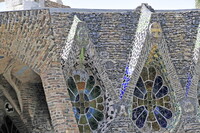Chapel of Colònia Güell
Gaudí, Antoni

Download1A1-GA-CCG-A55_cp.jpg (779.5Kb)
Alternative Titles
Cripta de la Colònia Güell
Church of Colònia Güell
Date
1908-1915Description
Detail, tile inset gable-like forms in the brick and rubble wall with teardrop windows; The chapel for the Colonia Güell, a settlement for Güell textile workers at Santa Coloma de Cervelló, near Barcelona, was commissioned in 1898. Its form was derived from a unique catenary modeling system, which Gaudi invented using wires, canvas, threads and hanging weights to simulate the structural stresses. The interior is created from highly complex ribbed vaults of stone, brick and tile in squat, quasi-parabolic shapes carried on inclined columns of roughly chiseled stone and textured brick. Outside, inclined rubble walls and columns grow out of the ground like trees, with teardrop-shaped windows between their roots. The whole building expressed Gaudí’s aim to achieve an organic unity of space, form and structure, in which each element was determined by analogy with nature; an aim reinforced by the exaggeration of the primitivist forms. Only the crypt was completed; it was dedicated in 1915. It was restored in 2000-2002 and some of the unfinished aspects were removed and the roof stabilized. (The roof would have formed the floor of the chapel above.) Source: Grove Art Online; http://www.oxfordartonline.com/ (accessed 5/22/2013)
Type of Work
chapel (room or structure); cryptSubject
architecture, Modernista, Modernisme, Twentieth century, Art Nouveau
Rights
Rights Statement
Licensed for educational and research use by the MIT community only